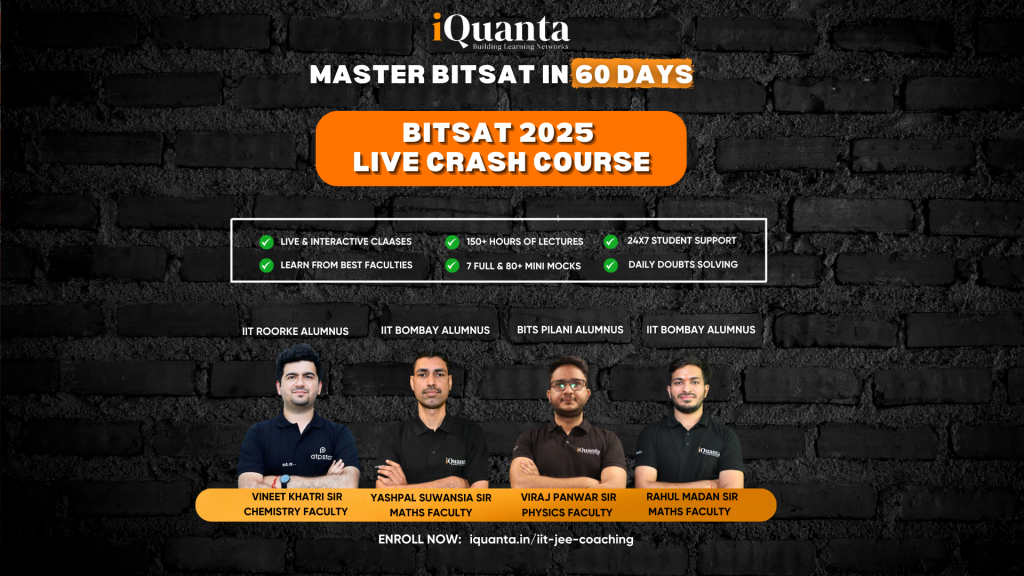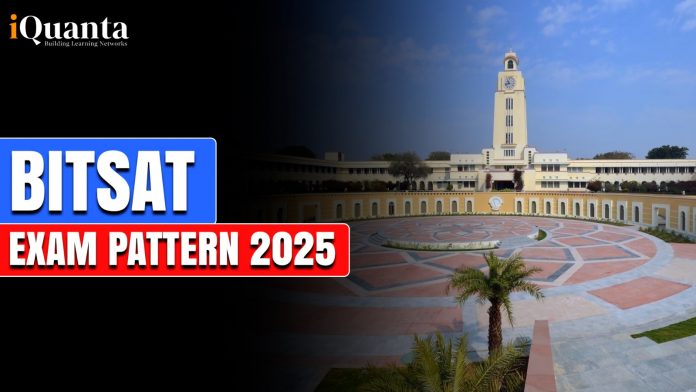Preparing for BITSAT 2025? Understanding the exam pattern is the first step towards success. BITSAT is known for its unique format, with 130 questions across Physics, Chemistry, Mathematics/Biology, English, and Logical Reasoning. With a strict marking scheme and additional bonus questions, smart time management is essential. In this guide, we break down the BITSAT exam pattern 2025, helping you strategize for a high score and secure admission to BITS Pilani, Goa, or Hyderabad.
Join the BITSAT Course by iQuanta

BITSAT Exam Pattern 2025 – Overview
BITSAT 2025 is an online computer-based test (CBT) that evaluates students on Physics, Chemistry, Mathematics, English Proficiency, and Logical Reasoning. The exam follows a fixed pattern every year. Here are the key highlights of the BITSAT 2025 exam pattern:
- Mode of Exam: Online (Computer-Based Test)
- Duration: 3 hours (180 minutes)
- Total Questions: 130
- Subjects Covered: Physics, Chemistry, Mathematics/Biology, English Proficiency, and Logical Reasoning
- Marking Scheme:
- +3 marks for each correct answer
- -1 mark for each incorrect answer
- 0 marks for unattempted questions
- Additional Questions: 12 extra questions available for students who complete the main exam early
- Medium of Exam: English only
BITSAT 2025 Exam Pattern- Section-wise Distribution of Questions
BITSAT 2025 consists of four sections, with a total of 130 multiple-choice questions (MCQs). Below is the subject-wise distribution of questions:
| Subject | Number of Questions |
| Physics | 30 |
| Chemistry | 30 |
| Mathematics/Biology | 40 |
| English Proficiency | 10 |
| Logical Reasoning | 10 |
| Total | 130 |
Join the BITSAT Course by iQuanta

BITSAT 2025 Exam Pattern for Physics (30 Questions)
Physics in BITSAT includes topics from Class 11 and Class 12. Questions are conceptual and require strong problem-solving skills. Topics include Laws of Motion, Current Electricity, Thermodynamics, Optics, Electrostatics and Modern Physics.
| Chapter | Weightage |
| Magnetic Effect of Current, Heat and Thermodynamics | 10% |
| Wave, Optics, Fluids, Motion, Current Electricity | 6% |
| Simple Harmonic Motion, Rotational Motion, Electrostatics | 5% |
| Units, Dimensions and Errors, Gravitation | 4% |
| Elasticity, Work, Power and Energy, Alternating Current | 3% |
BITSAT Exam Pattern 2025 for Chemistry (30 Questions)
This section is divided into Physical, Organic, and Inorganic Chemistry. Important topics include Chemical Bonding, Thermodynamics, Organic Reactions and Mechanisms, Coordination Compounds, Atomic Structure, Polymers and Biomolecules, etc.
| Chapter | Weightage |
| Chemical Bonding | 10% |
| Carboxylic Acid and Its Derivatives, Biomolecules, Mole Concepts, p-block Elements, Atomic Structure | 6% |
| Electrochemistry, Chemical Thermodynamics, Alkanes, Alkenes and Alkynes | 5% |
| General Organic Chemistry, Solid State, s-block Elements, Chemical Equilibrium | 4% |
| Chemical Kinetics, Ionic Equilibrium | 3% |
Join the BITSAT Course by iQuanta

BITSAT Exam Pattern 2025 for Mathematics/Biology (40 Questions)
Mathematics: For students applying for B.Tech programmes, topics include Algebra, Calculus, Probability, Trigonometry, Coordinate Geometry, etc.
Biology: For students applying for B.Pharm programmes, topics include Genetics, Ecology, Biotechnology, Cell Structure, etc.
| Chapter | Weightage |
| Circles | 11% |
| Pair of Straight Lines, Straight Lines | 7% |
| Differential Calculus, Vectors | 6% |
| Binomial Theorem, Differential Equation, Set Theory and Relations, Complex Numbers | 4% |
| Matrices and Determinants, Probability, Trigonometric Ratios, Functions and Identities, Properties of Triangles, Application of Derivatives | 3% |
BITSAT Exam Pattern 2025 for English Proficiency and Logical Reasoning (10 + 20 Questions)
This section tests basic English skills, such as Grammar, Vocabulary, Sentence Completion, Synonyms & Antonyms, Reading Comprehension, etc. Logical reasoning evaluates a candidate’s analytical and critical thinking abilities. Topics include Puzzle Solving, Figure-Based Questions, Coding-Decoding, Number & Alphabet Series, Syllogisms, etc.
| Chapter | Weightage |
| Figure Formation and Analysis, Figure Matrix | 40% |
| Synonyms and Antonyms | 30% |
| Analogy | 20% |
| Rearrangement, Sentence Completion, One-Word Substitution | 15% |
| Logical Deduction, Series Completion | 10% |
| Paper Cutting | 7% |
| Rule Detection | 5% |
| Prepositions, Tenses, Modals | 3% |
Join the BITSAT Course by iQuanta

BITSAT 2025 Exam Pattern – 12 Questions
BITSAT has a unique feature that allows candidates to attempt 12 additional questions if they finish the 130 questions before the 3-hour limit. However, once a student chooses to attempt these extra questions, they cannot go back to modify previous answers.
These extra 12 questions are distributed as follows:
- 3 from Physics
- 3 from Chemistry
- 3 from Mathematics/Biology
- 3 from Logical Reasoning
Attempting these extra questions can boost scores but also increases the risk of negative marking. Hence, students should use this feature wisely.
BITSAT Exam Pattern 2025 – Marking Scheme and Negative Marking
BITSAT 2025 follows a strict marking scheme:
- +3 marks for every correct answer
- -1 mark for every incorrect answer
- 0 marks for unanswered questions
Since there is negative marking, students should avoid guessing randomly. If unsure about an answer, it is better to skip the question rather than lose marks.
Join the BITSAT Course by iQuanta

BITSAT 2025 Exam Duration and Time Management
The total duration of the exam is 3 hours (180 minutes). There is no sectional time limit, so candidates can allocate time based on their strengths. Suggested time management strategy is as follows:
| Subject | Time Management |
| Physics | 35-40 minutes |
| Chemistry | 35-40 minutes |
| Mathematics/Biology | 50-60 minutes |
| English & Logical Reasoning | 20-25 minutes |
| Review & Extra Questions | 10-15 minutes |
How to Prepare for BITSAT 2025 Based on the Exam Pattern
Understand the Syllabus
Download and go through the official BITSAT 2025 syllabus to ensure you cover all topics.
Practice Time Management
Since the exam has 130 questions in 180 minutes, speed is crucial. Practice solving mock tests within the time limit.
Use Previous Year Papers
Solving previous year BITSAT papers helps understand the question pattern and difficulty level.
Focus on Accuracy
Avoid negative marking by answering only those questions you are sure about.
Take Mock Tests Regularly
Mock tests help improve speed, accuracy, and confidence. Analyze your performance after each test.
Improve English and Logical Reasoning Skills
Since this section carries 30 marks, improving English and Logical Reasoning can boost your overall score.
Take Up A Crash Course
By managing time well and practicing regularly, students can improve their chances of scoring high and securing admission to BITS Pilani, Goa, or Hyderabad. Here is one crash course that you can opt for – iQuanta’s BITSAT 2025 .Crash Course
Join the BITSAT Course by iQuanta

BITSAT Crash Course 2025 by iQuanta
The course is structured into three phases for effective preparation:
| Phase | Focus | What’s Provided | What Students Should Do |
| 1 | Build clarity, master basics, and develop problem-solving skills. | 1185+ concept video lectures and exclusive videos. | Watch videos, solve Master Question Bank, and practice with DPPs. |
| 2 | Strengthen each chapter and improve problem-solving speed and accuracy. | Intensive practice sessions to refine skills. | Take chapter-wise tests, part tests, and discuss previous years’ questions in lectures. |
| 3 | Develop the right strategy for BITSAT 2025, manage time efficiently, and build confidence. | Final revision materials, formula sheets, and test-taking strategies. | Attempt full-length mock tests to assess exam readiness. |
BITSAT Crash Course 2025: Key Highlights
- Complete Revision: Covers all subjects – Physics, Chemistry, Mathematics/Biology, English Proficiency, and Logical Reasoning.
- Extensive Practice: Includes 5000+ high-quality, exam-relevant questions in the Master Question Bank.
- Mock Tests: Get 7 full-length tests and 3 part-wise tests to experience the real exam format.
- Concept Videos & Analysis: Detailed video explanations and trend analysis of the last 10 years’ questions.
- Daily Practice Problems (DPPs): Helps track progress and improve retention.
New Features in BITSAT 2025 Crash Course
- 1000+ Concept Videos for Physics, Chemistry, and Mathematics to clarify fundamental concepts.
- Focused Practice: A Master Question Bank with 3000+ topic-wise questions to strengthen weak areas.
- Formula Booklet: Separate formula sheets for Physics, Chemistry, and Mathematics for quick revision.
Join the BITSAT Course by iQuanta

BITSAT Exam Pattern 2025 – FAQs
Yes, BITSAT 2025 registration started on January 21, 2025. Candidates can apply online at bitsadmission.com. The last date to submit the application for Session 1 is April 18, 2025. If you wish to appear only for Session 2, registration starts on May 26, 2025, and ends on June 10, 2025. Make sure to complete your registration before the deadline.
To apply for BTech through BITSAT 2025, candidates must have passed Class 12 in 2024 or 2025 with Physics, Chemistry, and Mathematics as compulsory subjects. A minimum of 75% aggregate in PCM and at least 60% in each subject is required. Students who appeared for Class 12 in 2023 or earlier are not eligible. Direct admission is available for board toppers.
The BITSAT 2025 cut-off depends on the difficulty level, number of applicants, and seat availability. The expected cut-off for BITS Pilani is 270-300+, for BITS Goa around 250-280, and for BITS Hyderabad around 240-270. However, the actual cut-off will be announced after the exam based on merit and seat allocation.
BITSAT 2025 is an online exam with 130 multiple-choice questions divided into Physics (30 questions), Chemistry (30 questions), Mathematics/Biology (40 questions), English Proficiency & Logical Reasoning (20 questions). Each correct answer gives +3 marks, and each wrong answer deducts 1 mark. Extra 12 questions are available if all 130 questions are attempted.
BITSAT 2025 has a total of 390 marks. Each correct answer gives +3 marks, while each incorrect answer deducts 1 mark. If a candidate attempts all 130 questions, they can access 12 extra questions, increasing the potential score. The final score is calculated based on correct answers and negative marking.

